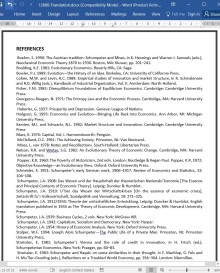
دانلود مقاله تکامل تئوری اقتصادی شومپیتر چگونه است؟
علیرغم کارهای برجسته جوزف ا. شومپیتر از نظر ارجاعات، چیزی مانند مکتب شومپیتر در اقتصاد وجود ندارد- حتی با وجود این که در دوران تصدی وی در دانشگاه هاروارد از سال 1932 تا زمان مرگش در سال 1950، شومپیتر شاگردان بسیار با استعدادی داشت. از جمله شاگردان او که فقط به ذکر چند مورد میپردازیم عبارتند از برگسون ، ژرژسو-روژن ، گودوین ، هیرشلیفر ، موسگریو ، ساموئلسون ، استولپر و توبین - که به نوبه خود اقتصاددانان برجستهای بودند، اگرچه کلاسهای شومپیتر را تحسین نمیکردند، با علاقه از آن یاد میکردند. با این حال، در تحقیقاتشان، راههای متنوعی را پشت سر گذاشتند بدون آنکه بیش از حد، اندیشه شومپیتر را بر توسعه سرمایهداری مدرن اعمال کنند. دلیل آن که در اینجا ارائه خواهد شد، این است که شومپیتر هیچ سیستم نظری قطعی را برای شاگردان خود، مانند میل یا مارشال که در قبل از خودش و ساموئلسون پس از خودش مرده بودند، باقی نگذاشته بود. آنچه او به جا گذاشت این بود كه با موضوعات بسیار گسترده با روشی نسبتاً الكترونیكی روبرو شوند، هرچند كه با چارچوب و جهانبینی اقتصادی متمایز با آن تفسیر شود.
بدون شک دو اثر بسیار عالی و اصلی او عبارتند از نظریه توسعه اقتصادی (1912/1934) و سرمایه داری، سوسیالیسم و دموکراسی (1942) - که شومپیتر در آنها به وضوح جهانبینی خود را آشکار میکند. به نظر میرسد این جهانبینی تا حدودی با تجربه تاریخی خود شومپیتر درباره روند رشد اقتصادی ناپایدار و نامتعادل در دوره «ترویج» و گسترش سریع صنعت در اروپا در اواخر قرن نوزدهم و اوایل قرن بیستم، و بخشی نیز از تأثیر و بازگرداندن آموزههای عامهپسند مارکسیستی توسعه سرمایهداری مستعد بحران شکل گرفته است. توسعه اقتصادی سرمایهداری ضمن عبور از رونق و بحرانها، رونق و رکود اقتصادی، سطح پیشرفت اقتصادی ناشناختهای را در تولید، مصرف، ارز و حتی در بستر نهادی اقتصاد ایجاد کرده بود. هرگونه تلاشی برای نظریهپردازی سوابق تاریخی (و در واقع، توسعه مداوم آن زمان) به آسانی میتواند نقش نوآوریها و کارآفرینی و تغییر اقتصادی مداوم در تمام سطوح اقتصاد را در نظر گیرد. با این حال، هنگامی که شومپیتر جوان در حال نوشتن بود، تمام این مفاهیم و مفروضات نظری مربوطه، در بهترین حالت، در حاشیه تئوری اقتصادی به شکلی آزادانهای مورد بحث قرار میگرفت. در حقیقت، این مفاهیم در خارج از الگوی نیوتنی برگرفته از اقتصاد همیشه متعادل و ایستا بود، الگویی که تحت تأثیر نویسندگانی چون جونز ، والراس ، ادگورث ، پارتو ، کلارک و مارشال بوده و تا اوایل قرن بیستم پایبندی روزافزونی بدست آورد.
نتیجهگیری
در این مقاله نشان داده شد كه كار شومپیتر در زمینه تئوری توسعه اقتصادی طی دو مرحله به نتایج كاملاً متفاوت در كتابهای وی در سالهای 1912 و 1942 منتهی شد. اگرچه بدیهی است که شومپیتر درک روشنی از ویژگی كلی نظریه تكامل دارد. او به روش اصلی و بدون وام گرفتن از قیاسهای داروینی، نظریهای ارائه داد که امروزه در اقتصاد تکاملی مد است- او نتوانست نظریه کلی و رضایت بخش تکامل اقتصادی را تدوین کند. در عوض، رویکرد وی به توسعه اقتصادی در واقع یتئوری ویژه از روند رشد ناپایدار سرمایهداری است که از رونق و بحران عبور میکند. بنابراین، شومپیتر در طول تمام آثار خود، درکش را از پدیده چرخه کسب و کار و اشغال بهبود داده بود. این قالببندی اکتشافی خاص نه تنها برخی فرضیههای عجیب و غریب را میپذیرد که پذیرفتن آنها در چارچوب تکاملی دشوار است، بلکه برخی از کاستیها در درک او از (آنچه وی حاضر به فراخواندن آن است) روند تکاملی اقتصادی را نشان میدهد.
نقش اصلی در تئوری توسعه اقتصادی شومپیتر، نقش مروج- کارآفرین است. تصویر کارآفرینی که به توسعه سوق میدهد، به استعاره محبوب برای رویکرد تکاملی تبدیل شده است، اما همانطور که گفته شد، تصویر نسبتاً یک طرفهای از منبع و نیروی محرکه فرآیند خود تحول در اقتصاد را ترسیم میکند. شومپیتر بعداً نظریه محور کارآفرین خود را کنار گذاشت. شومپیتر با الهام از دیدگاه بزرگ و سخت روند تاریخی سرمایهداری که آشکارا از ماتریالیسم تاریخی مارکس الهام گرفته بود، استدلال میکند که کارآفرین نوآور منسوخ شده است. نقش کارآفرین، به عنوان یک امر معمول، به بوروکراسی اعتمادهای بزرگ جذب شده بود. این امانتها برای حفظ سرمایهگذاریهای نوآورانه در مقیاس بزرگ خود از اقدامات پیشگیرانهای استفاده میكنند كه منجر به اعمال انحصارطلبی میشود. این شیوهها (در صورت موفقیت) اجازه میدهد تا با فعالیتهای نوآورانه، درآمد حاصل شود، اما در عین حال طرفداران تلاشهای بیشتری در زمینه نوآوری بدست میآورند،بنابراین آنچه را که شومپیتر به عنوان «غده دیرینه تخریب خلاق» مینامد جایگاههای بازار انحصارآمیز و سودده را القا میکند.
اگرچه این حدسها، مقالات وسیع نظری و تجربی را ایجاد کردهاند که سهم آنها در تئوری کلیتر از روند تکاملی در اقتصاد بسیار محدود بوده است. از این رو هیچکدام از مشکلات پیش روی تفسیر قبلی شومپیتر از توسعه اقتصادی قابل حل نیست. در حالی که تحقیقات نوآوری، نه تنها با بحث درباره «فرض شومپیتر» در مورد روابط بین نوآوری و ساختار بازار ایجاد شده پیشرفت زیادی داشته است، جایگاه مناسبی در نوآوریها و انگیزه پیگیری آنها در تئوری تکاملی اقتصادی داشته است. هنوز روند نیاز به روشنسازی دارد. مدلهای نئوکلاسیک تصمیمات مطلوب نوآوری و نئونوآوری که در سالهای اخیر با تعداد زیادی ظاهر شدهاند، نمیتوانند به عنوان جایگزین عمل کنند. دلیل این امر آن است که آنها خلاف تئوری توسعه اقتصادی شومپیتر را در نظر نمیگیرند- جریان بیرونی از فرصتهای نوآوری با خصوصیات عمدتاً شناختهشده در نظر گرفته میشود. بنابراین آنها فرضی را در نظر میگیرند که در نگاه تکاملی باید در وهله اول توضیح داده شود.
Despite the enormous prominence of the work of Joseph A. Schumpeter in terms of citations there is nothing like a Schumpeterian school in economics—even though, particularly during his tenure at Harvard University from 1932 until his death in 1950, Schumpeter had extremely talented students in his classes. Many of them—Bergson, Georgescu-Roegen, Goodwin, Hirshleifer, Musgrave, Samuelson, Stolper, and Tobin, to mention just a few—became eminent economists in their own right, and usually recalled Schumpeter’s classes with sympathy, if not admiration. In their research, however, they went their own, diverse ways without carrying Schumpeter’s thought on the development of modern capitalism much further. The reason, it will be claimed here, is that Schumpeter left no conclusive theoretical system to his students, as did Mill or Marshall before him, and Samuelson after him. What he left rather was an oeuvre dealing with an enormously broad range of topics in a rather eclectic fashion, albeit framed by, and interpreted within, a distinct economic world-view.
It is especially in his two great, and undisputedly most original, works—The Theory of Economic Development (1912/1934) and Capitalism, Socialism and Democracy (1942)—that Schumpeter most clearly reveals his world-view. It seems to be shaped partly by Schumpeter’s own historical experience of the unsteady and unbalanced economic growth process in the period of ‘‘promoterism’’ and rapid industrial expansion in Europe in the late 19th and early 20th centuries, and partly by the impact and the repercussion of the popular Marxist teachings of a crisis-prone capitalist development. While passing through booms and crises, prosperity and depression, capitalist economic development had created previously unknown levels of economic achievement in production, consumption, exchange, and even in the institutional set-up of the economy. Any attempt to theorize that historical record (and, indeed, the continuing development since) can hardly fail to take account of the role of innovations and innovativeness, of entrepreneurship, and of incessant economic change at all levels of the economy. Yet, when the young Schumpeter was writing, all these concepts and the corresponding theoretical conjectures were, at best, discussed loosely at the margins of economic theory. In fact, these concepts stood outside the Newtonian paradigm of an ever-equilibrating economy, a paradigm that, under the influence of writers like Jevons, Walras, Edgeworth, Pareto, Clark, and Marshall had gained increasing adherence by the early years of the 20th century.
CONCLUSIONS
In this paper it has been argued that Schumpeter’s work on the theory of economic development proceeded through two quite different stages resulting in his books of 1912 and 1942. Although Schumpeter had obviously a clear understanding of the general character of an evolutionary theory—an understanding which he derived in an original way without borrowing from Darwinian analogies as is fashionable today in evolutionary economics—he did not succeed in formulating a satisfactory, general theory of economic evolution. Rather his approach to economic development is actually a special theory of the unsteady capitalist growth process passing though booms and crises. Throughout his entire oeuvre Schumpeter was therefore occupied with improving his grasp of the business cycle phenomenon. This special heuristic framing implies not only some rather peculiar hypotheses which are diffcult to accept within an evolutionary framework, but also some shortcomings in his understanding of (what he refused to call) the economic evolutionary process.
Central to Schumpeter’s theory of economic development is the role of a promoter– entrepreneur. The image of the entrepreneur who propels development has become a popular metaphor for the evolutionary approach, yet as has been argued, it draws a rather one-sided portrait of the source and driving force of the self-transformation process in the economy. Schumpeter later abandoned his entrepreneur-centred theory. In a speculative grand view of the historical trend of capitalism obviously inspired by Marx’s historical materialism, Schumpeter argued that the innovative entrepreneur had become obsolete. The entrepreneur’s role had been absorbed, as a matter of routine, into the bureaucracies of the large trusts. In order to protect their largescale innovation ventures these trusts use precautionary measures which result in monopolistic practices. These practices (if successful) allow returns to be earned on innovative activities, yet, at the same time the profits attract further innovation efforts, thereby inducing what Schumpeter calls a ‘‘perennial gale of creative destruction’’ of monopolistic market positions and profits.
Although these conjectures have spawned a vast theoretical and empirical literature their contribution to a more general theory of the evolutionary process in the economy has been a limited one. None of the problems facing Schumpeter’s earlier interpretation of economic development could thus be solved. While innovation research, triggered not least by the debate on the ‘‘Schumpeterian hypothesis’’ concerning the relationships between innovativeness and market structure, has made great progress, the proper place of innovations and the motivation to pursue them within an evolutionary theory of the economic process still needs clarification. Neo- classical models of optimal innovation decisions and innovation races, which have emerged in large number in recent years, cannot serve as substitutes. The reason is that they assume—not unlike Schumpeter’s theory of economic development—an exogenously given flow of innovation possibilities with largely known properties. They thus presuppose what, in an evolutionary perspective, needs to be explained in the first place.
تئوری تکاملی چیست؟
«تئوری توسعه اقتصادی»- ارزیابی بحرانی
تجارب آمریکا و بازگشت به تاریخ گرایی
نتیجهگیری
منابع
WHAT IS AN EVOLUTIONARY THEORY?
THE ‘‘THEORY OF ECONOMIC DEVELOPMENT’’—A CRITICAL ASSESSMENT
AMERICAN EXPERIENCES AND THE TURN TO HISTORICISM
CONCLUSIONS
REFERENCES
- اصل مقاله انگلیسی با فرمت ورد (word) با قابلیت ویرایش
- ترجمه فارسی مقاله با فرمت ورد (word) با قابلیت ویرایش، بدون آرم سایت ای ترجمه
- ترجمه فارسی مقاله با فرمت pdf، بدون آرم سایت ای ترجمه


